Tomohiro Nakatani
Reference Microphone Selection for Guided Source Separation based on the Normalized L-p Norm
Oct 31, 2025



Abstract:Guided Source Separation (GSS) is a popular front-end for distant automatic speech recognition (ASR) systems using spatially distributed microphones. When considering spatially distributed microphones, the choice of reference microphone may have a large influence on the quality of the output signal and the downstream ASR performance. In GSS-based speech enhancement, reference microphone selection is typically performed using the signal-to-noise ratio (SNR), which is optimal for noise reduction but may neglect differences in early-to-late-reverberant ratio (ELR) across microphones. In this paper, we propose two reference microphone selection methods for GSS-based speech enhancement that are based on the normalized $\ell_p$-norm, either using only the normalized $\ell_p$-norm or combining the normalized $\ell_p$-norm and the SNR to account for both differences in SNR and ELR across microphones. Experimental evaluation using a CHiME-8 distant ASR system shows that the proposed $\ell_p$-norm-based methods outperform the baseline method, reducing the macro-average word error rate.
MOVER: Combining Multiple Meeting Recognition Systems
Aug 07, 2025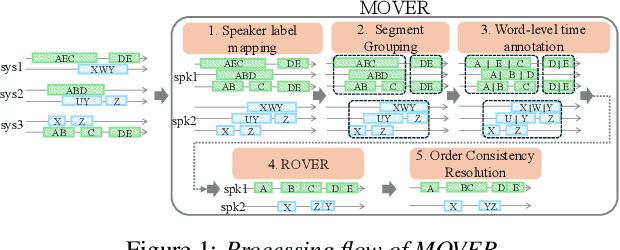


Abstract:In this paper, we propose Meeting recognizer Output Voting Error Reduction (MOVER), a novel system combination method for meeting recognition tasks. Although there are methods to combine the output of diarization (e.g., DOVER) or automatic speech recognition (ASR) systems (e.g., ROVER), MOVER is the first approach that can combine the outputs of meeting recognition systems that differ in terms of both diarization and ASR. MOVER combines hypotheses with different time intervals and speaker labels through a five-stage process that includes speaker alignment, segment grouping, word and timing combination, etc. Experimental results on the CHiME-8 DASR task and the multi-channel track of the NOTSOFAR-1 task demonstrate that MOVER can successfully combine multiple meeting recognition systems with diverse diarization and recognition outputs, achieving relative tcpWER improvements of 9.55 % and 8.51 % over the state-of-the-art systems for both tasks.
Description and Discussion on DCASE 2025 Challenge Task 4: Spatial Semantic Segmentation of Sound Scenes
Jun 12, 2025


Abstract:Spatial Semantic Segmentation of Sound Scenes (S5) aims to enhance technologies for sound event detection and separation from multi-channel input signals that mix multiple sound events with spatial information. This is a fundamental basis of immersive communication. The ultimate goal is to separate sound event signals with 6 Degrees of Freedom (6DoF) information into dry sound object signals and metadata about the object type (sound event class) and representing spatial information, including direction. However, because several existing challenge tasks already provide some of the subset functions, this task for this year focuses on detecting and separating sound events from multi-channel spatial input signals. This paper outlines the S5 task setting of the Detection and Classification of Acoustic Scenes and Events (DCASE) 2025 Challenge Task 4 and the DCASE2025 Task 4 Dataset, newly recorded and curated for this task. We also report experimental results for an S5 system trained and evaluated on this dataset. The full version of this paper will be published after the challenge results are made public.
Microphone Array Signal Processing and Deep Learning for Speech Enhancement
Jan 13, 2025



Abstract:Multi-channel acoustic signal processing is a well-established and powerful tool to exploit the spatial diversity between a target signal and non-target or noise sources for signal enhancement. However, the textbook solutions for optimal data-dependent spatial filtering rest on the knowledge of second-order statistical moments of the signals, which have traditionally been difficult to acquire. In this contribution, we compare model-based, purely data-driven, and hybrid approaches to parameter estimation and filtering, where the latter tries to combine the benefits of model-based signal processing and data-driven deep learning to overcome their individual deficiencies. We illustrate the underlying design principles with examples from noise reduction, source separation, and dereverberation.
* Accepted for IEEE Signal Processing Magazine
NTT Multi-Speaker ASR System for the DASR Task of CHiME-8 Challenge
Sep 09, 2024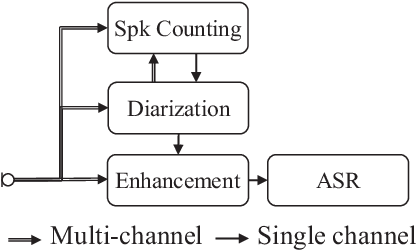
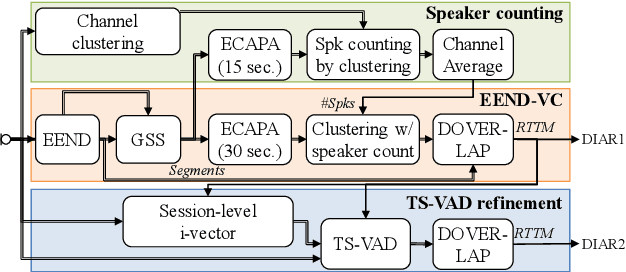


Abstract:We present a distant automatic speech recognition (DASR) system developed for the CHiME-8 DASR track. It consists of a diarization first pipeline. For diarization, we use end-to-end diarization with vector clustering (EEND-VC) followed by target speaker voice activity detection (TS-VAD) refinement. To deal with various numbers of speakers, we developed a new multi-channel speaker counting approach. We then apply guided source separation (GSS) with several improvements to the baseline system. Finally, we perform ASR using a combination of systems built from strong pre-trained models. Our proposed system achieves a macro tcpWER of 21.3 % on the dev set, which is a 57 % relative improvement over the baseline.
Interaural time difference loss for binaural target sound extraction
Aug 01, 2024

Abstract:Binaural target sound extraction (TSE) aims to extract a desired sound from a binaural mixture of arbitrary sounds while preserving the spatial cues of the desired sound. Indeed, for many applications, the target sound signal and its spatial cues carry important information about the sound source. Binaural TSE can be realized with a neural network trained to output only the desired sound given a binaural mixture and an embedding characterizing the desired sound class as inputs. Conventional TSE systems are trained using signal-level losses, which measure the difference between the extracted and reference signals for the left and right channels. In this paper, we propose adding explicit spatial losses to better preserve the spatial cues of the target sound. In particular, we explore losses aiming at preserving the interaural level (ILD), phase (IPD), and time differences (ITD). We show experimentally that adding such spatial losses, particularly our newly proposed ITD loss, helps preserve better spatial cues while maintaining the signal-level metrics.
Array Geometry-Robust Attention-Based Neural Beamformer for Moving Speakers
Feb 05, 2024Abstract:Recently, a mask-based beamformer with attention-based spatial covariance matrix aggregator (ASA) was proposed, which was demonstrated to track moving sources accurately. However, the deep neural network model used in this algorithm is limited to a specific channel configuration, requiring a different model in case a different channel permutation, channel count, or microphone array geometry is considered. Addressing this limitation, in this paper, we investigate three approaches to improve the robustness of the ASA-based tracking method against such variations: incorporating random channel configurations during the training process, employing the transform-average-concatenate (TAC) method to process multi-channel input features (allowing for any channel count and enabling permutation invariance), and utilizing input features that are robust against variations of the channel configuration. Our experiments, conducted using the CHiME-3 and DEMAND datasets, demonstrate improved robustness against mismatches in channel permutations, channel counts, and microphone array geometries compared to the conventional ASA-based tracking method without compromising performance in matched conditions, suggesting that the mask-based beamformer with ASA integrating the proposed approaches has the potential to track moving sources for arbitrary microphone arrays.
Neural network-based virtual microphone estimation with virtual microphone and beamformer-level multi-task loss
Nov 20, 2023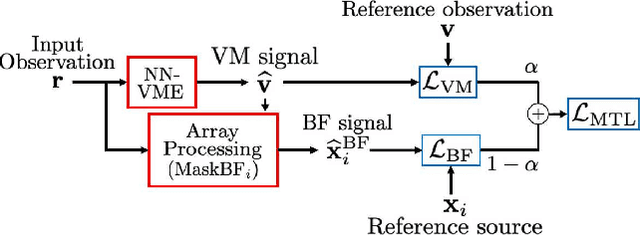
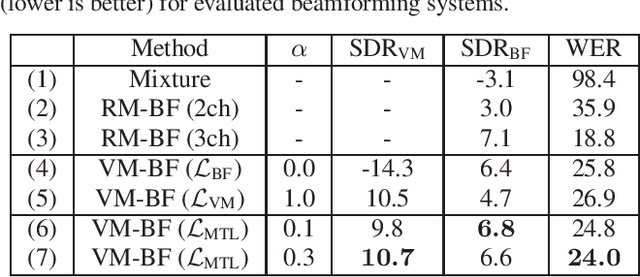
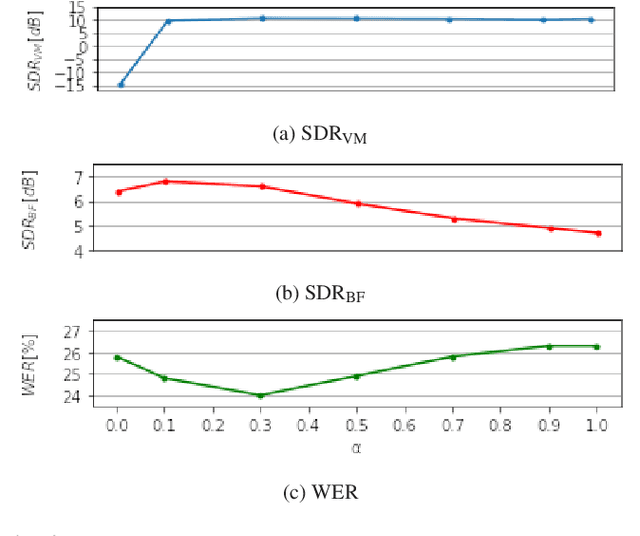
Abstract:Array processing performance depends on the number of microphones available. Virtual microphone estimation (VME) has been proposed to increase the number of microphone signals artificially. Neural network-based VME (NN-VME) trains an NN with a VM-level loss to predict a signal at a microphone location that is available during training but not at inference. However, this training objective may not be optimal for a specific array processing back-end, such as beamforming. An alternative approach is to use a training objective considering the array-processing back-end, such as a loss on the beamformer output. This approach may generate signals optimal for beamforming but not physically grounded. To combine the advantages of both approaches, this paper proposes a multi-task loss for NN-VME that combines both VM-level and beamformer-level losses. We evaluate the proposed multi-task NN-VME on multi-talker underdetermined conditions and show that it achieves a 33.1 % relative WER improvement compared to using only real microphones and 10.8 % compared to using a prior NN-VME approach.
Target Speech Extraction with Conditional Diffusion Model
Aug 17, 2023



Abstract:Diffusion model-based speech enhancement has received increased attention since it can generate very natural enhanced signals and generalizes well to unseen conditions. Diffusion models have been explored for several sub-tasks of speech enhancement, such as speech denoising, dereverberation, and source separation. In this paper, we investigate their use for target speech extraction (TSE), which consists of estimating the clean speech signal of a target speaker in a mixture of multi-talkers. TSE is realized by conditioning the extraction process on a clue identifying the target speaker. We show we can realize TSE using a conditional diffusion model conditioned on the clue. Besides, we introduce ensemble inference to reduce potential extraction errors caused by the diffusion process. In experiments on Libri2mix corpus, we show that the proposed diffusion model-based TSE combined with ensemble inference outperforms a comparable TSE system trained discriminatively.
Modified Parametric Multichannel Wiener Filter \\for Low-latency Enhancement of Speech Mixtures with Unknown Number of Speakers
Jun 29, 2023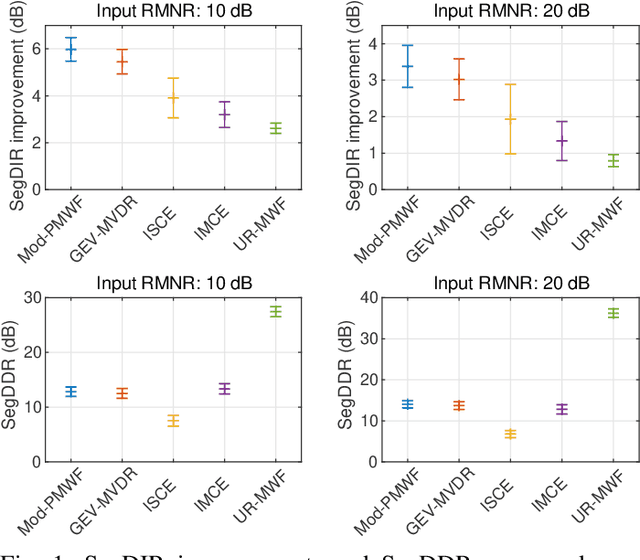
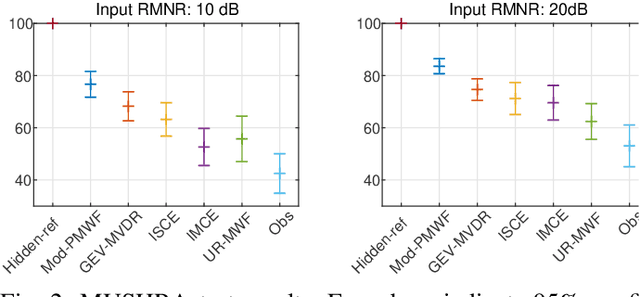
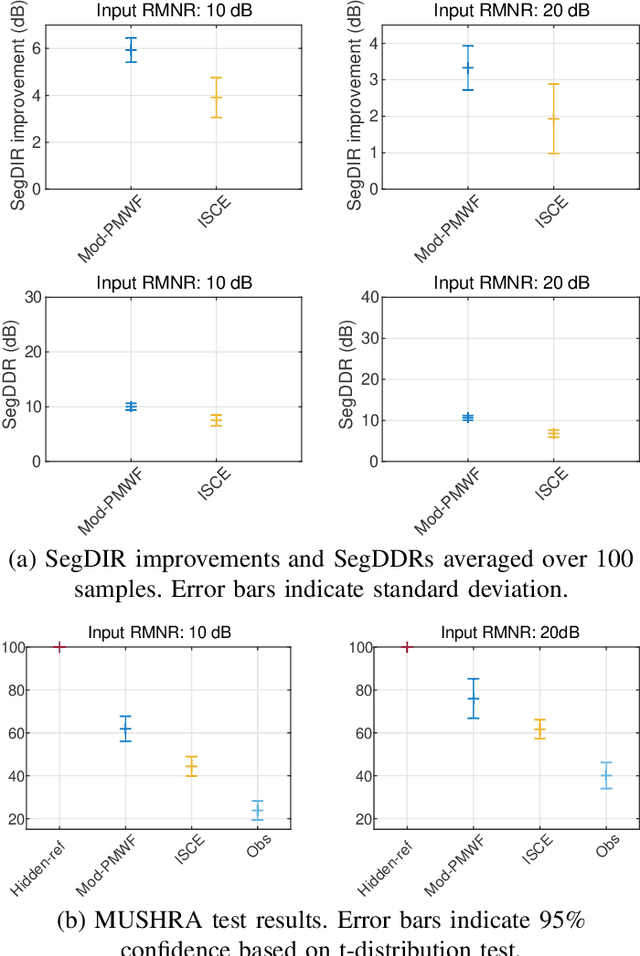

Abstract:This paper introduces a novel low-latency online beamforming (BF) algorithm, named Modified Parametric Multichannel Wiener Filter (Mod-PMWF), for enhancing speech mixtures with unknown and varying number of speakers. Although conventional BFs such as linearly constrained minimum variance BF (LCMV BF) can enhance a speech mixture, they typically require such attributes of the speech mixture as the number of speakers and the acoustic transfer functions (ATFs) from the speakers to the microphones. When the mixture attributes are unavailable, estimating them by low-latency processing is challenging, hindering the application of the BFs to the problem. In this paper, we overcome this problem by modifying a conventional Parametric Multichannel Wiener Filter (PMWF). The proposed Mod-PMWF can adaptively form a directivity pattern that enhances all the speakers in the mixture without explicitly estimating these attributes. Our experiments will show the proposed BF's effectiveness in interference reduction ratios and subjective listening tests.
 Add to Chrome
Add to Chrome Add to Firefox
Add to Firefox Add to Edge
Add to Edge